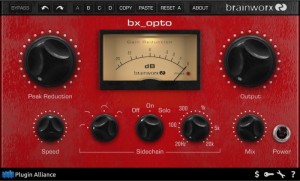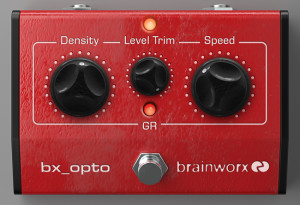Plugin Review: bx_opto and bx_opto Pedal from Brainworx
Last month, Plugin Alliance and Brainworx released the bx_opto compressor and the bx_opto Pedal—the latter of which is essentially a “diet” version of its big brother. These new plugins are based on traditional optical compressor designs, but with some new tricks that make them extremely versatile.
In an age of software emulations of specific hardware pieces, it’s a pleasant change to see companies thinking outside of the box a bit. I jumped at the chance to review these plugs because, while I love traditional opto compressors, they’re not often the most flexible of processors.
Before delving into the new tricks, let’s first talk a little bit about optical compressor circuits, which may be a bit of a mystery to the uninitiated:
A hardware optical compressor uses a program-dependent light source and a light-dependent photocell to control its detector circuit. Simply put, the louder the audio signal, the brighter the light gets and the greater the gain reduction, but also, the longer the decay or ”release” time becomes. This results in smooth, non-linear compression with few controls—often just gain reduction and makeup gain, as evidenced by the legendary Teletronix LA-2A.
The major draw to the bx_opto is its added “Speed” control. Traditional optical circuits have a fixed release time based on the idiosyncrasies of the light decay in their level detectors, but Brainworx has defied the laws of (analog) nature and added adjustable release time control. (According to the manual, the Speed control has little effect on the attack time.) This opens up a whole new world for optical compression.
I tested bx_opto on sung vocals and bass, which is where I usually prefer something like an LA-2A, but also on rap vocals, acoustic guitars and turntables – places where I generally reach for something with a snappier response in the release.
The opto handled all comers like a champ. It smoothed out the dynamics of the rap vocals while being fast enough for the quicker lyrical pace. It allowed enough transients and detail through for the guitar, while also locking it solidly in place.
“Solid” is a great description of the bx_opto compressor: It’s got a full-but-not-boomy bottom end, and with the inclusion of the ever-popular sidechain filter, low end pumping from things like bass thrusts on the turntables is an easy fix. In fact, this is one of the more flexible sidechain filters I’ve seen. It includes not only a variable filter ranging from 20Hz to 20kHz, but also four different filter types: High Pass, Low Pass, and two Band Pass settings. To round out the features, Brainworx has also included the now-ubiquitous “Mix” dial for parallel compression.
The bx_opto Pedal is a trimmed down version of the full-blown opto. It lacks the sidechain filter section and “Mix” knob, and combines peak control and output gain into one knob called “Density.” The pedal is still a very useful tool, and saw a lot of time on bass tracks in my studio. The pedal version also includes a Trim knob if you like to overdrive certain sources but control your gain staging, like I do.
If you’re on the hunt for transparent compression, this may not be your game, but if you want both character and versatility then the bx_opto might be for you. I’m a big supporter of plugin makers that seek to spurn the limits of analog traditions and treat digital like the wide world of endless possibilities it really is. With that at heart, the bx_opto compressors put a new and welcome spin on a classic design, and sound great while doing it.
Please note: When you buy products through links on this page, we may earn an affiliate commission.








